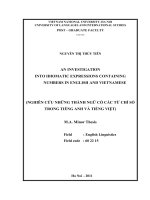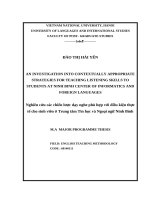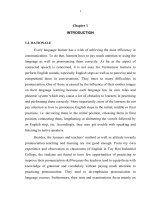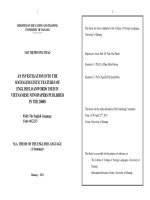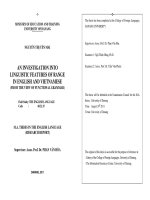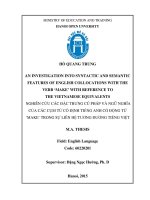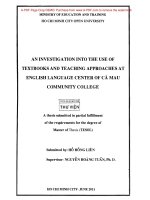An investigation into demotivating factors influencing on students’ english learning at ton duc thang university
Bạn đang xem bản rút gọn của tài liệu. Xem và tải ngay bản đầy đủ của tài liệu tại đây (1 MB, 108 trang )
STATEMENT OF AUTHORSHIP
I certify that this thesis entitled “An investigation into demotivating factors
influencing on students’ English learning at Ton Duc Thang University” is my own
work.
Except where reference is made in the text of the thesis, this thesis does not contain
material published elsewhere or extracted in whole or in part from a thesis by which I
have qualified for or been awarded another degree or diploma.
No other person’s work has been used without due acknowledgement in the main text of
this thesis.
This thesis has not been submitted for the award of any degree or diploma in any other
tertiary institution.
Ho Chi Minh City, December 2016
i
ACKNOWLEDGEMENTS
I would like to express my deepest gratitude to all of the following people for helping me
complete my thesis
Firstly, I would like to express my special thanks to my supervisor, Dr. Đặng Tấn Tín
for his helpful assistance and guidance. This thesis could have never been completed
without his enthusiastic counsel and support.
Secondly, I am extremely grateful to all of the lecturers of the TESOL program at Ho
Chi Minh City Open University for their helpful instructions during my M.A. course.
My appreciation also goes to my TESOL7 classmates for sharing me with a lot of useful
materials to complete my thesis.
In addition, my profound gratitude is also conveyed to the managing board, the English
teaching staff in the academic year of 2015–2016 at Tôn Đức Thắng University of for
giving me the best conditions to conduct the study
Last but not least, I would like to express my gratitude to my beloved family and my
friends at the same group under supervision of Dr. Đặng Tấn Tín for their support and
encouragement during the time of completing my thesis.
ii
ABSTRACT
In the field of foreign language education, demotivation has been widely regarded
as a major cause which negatively influences learners’ attitudes and behaviors, leading to
their undesired learning outcomes. Recognizing demotivating factors to EFL students’
learning, teachers can eliminate the possible causes of demotivation. Despite the
importance of teachers’ know-how about demotivating factors to EFL students’ learning,
only a limited number of studies have been carried out to understand and handle that
problem at Vietnamese educational context. Realizing the gap unfilled in the existing
literature, this study attempts to investigate into the likely demotivating factors in English
language learning at Ton Duc Thang University in Ho Chi Minh City. The study was
conducted as quantitative research. The sample of this study responded to 47-item
questionnaires to find out the demotivating factors that affect students' English learning
at Ton Duc Thang University. The data were collected through the questionnaire which
was directly delivered to students. The results revealed that students at Ton Duc Thang
University felt demotivated because of teachers’ competence and teaching styles, learning
contents, learners’ self-determination, and learners’ language utility. Among the reported
factors, learning contents most demotivate learners in learning whereas learning context
is the least influential factor to students’ attitudes toward and interests in learning English.
It is suggested that the university administrators, and teachers need to make changes in
English curricula so that students find more motivation and encouragement toward
learning English. In addition, students themselves should build up intrinsic motivation in
learning English. They should also try to overcome undesirable external factors that
diminish their motivational basis of their language learning. Prospective studies can
analyze qualitative data in order to deeply probe other demotivating factors to EFL
students’ learning and their attitudes about those factors.
iii
TABLE OF CONTENTS
STATEMENT OF AUTHORSHIP ...................................................................................... i
ACKNOWLEDGEMENTS ................................................................................................ ii
ABSTRACT ....................................................................................................................... iii
TABLE OF CONTENTS ................................................................................................. viii
LIST OF ABBREVIATIONS ........................................................................................... xii
LIST OF TABLES.............................................................................................................. ix
LIST OF FIGURES ............................................................................................................ xi
LIST OF APPENDIX ........................................................................................................ xii
CHAPTER 1: INTRODUCTION ........................................................................................ 1
1.1 Introduction ........................................................................................................... 1
1.2 Background of the study ....................................................................................... 1
1.3 Statement of problem ............................................................................................ 2
1.4 Purposes of the study ............................................................................................ 5
1.5 Research questions ................................................................................................ 6
1.6 Scope of the study ................................................................................................. 6
1.7 Significance of the study....................................................................................... 6
1.8 Organization of the study...................................................................................... 7
CHAPTER 2: LITERATURE REVIEW............................................................................. 9
2.1 Introduction ........................................................................................................... 9
2.2 Motivation in language learning ........................................................................... 9
2.2.1 Definitions of motivation .............................................................................. 9
viii
2.2.2 Developments in L2 motivation research .................................................... 10
2.3 Demotivation in language learning ..................................................................... 12
2.3.1 Definitions of demotivation......................................................................... 12
2.3.2 External and internal demotivation ............................................................. 13
2.3.3 Demotivating factors toward English language learning ............................ 16
2.3.4 Categories of demotivation in language learning ........................................ 20
2.3.5 Development of L2 demotivation research ................................................. 23
2.3.6 Demotivation and the related term Amotivation ......................................... 25
2.4 Empirical studies on related research ................................................................. 27
2.5 Summary of previous studies on demotivation .................................................. 34
2.6 Research gap ....................................................................................................... 36
2.7 Summary ............................................................................................................ 37
CHAPTER 3: RESEARCH METHODOLOGY ............................................................... 38
3.1 Research orientation ........................................................................................... 38
3.2 Research context ................................................................................................. 38
3.3 Learning material ................................................................................................ 39
3.4 Participants.......................................................................................................... 40
3.5 Instrument for data collection ............................................................................. 41
3.5.1 Rationale for the questionnaire.................................................................... 42
3.5.2 Description of the questionnaire to the students ......................................... 43
3.6 Methods for data collection ................................................................................ 44
3.6.1 Pilot study .................................................................................................... 44
3.6.2 Pilot of the questionnaire ............................................................................. 44
3.6.3 Reliability of the questionnaire ................................................................... 46
ix
3.7 Method for data analysis ..................................................................................... 47
3.8 Research procedure ............................................................................................. 48
3.9 Summary ............................................................................................................. 50
CHAPTER 4: FINDINGS AND DISCUCSSIONS .......................................................... 51
4.1 Introduction ......................................................................................................... 51
4.2 Students’ background information ..................................................................... 52
4.3 Research question 1: Level of demotivation ...................................................... 53
4.3.1 Findings ....................................................................................................... 53
4.3.2 Discussion for research question 1 .............................................................. 58
4.4 Research question 2: Demotivating factors ........................................................ 60
4.4.1 Findings ....................................................................................................... 60
4.4.2 Discussion for research question 2 .............................................................. 70
4.5 Chapter summary ................................................................................................ 73
CHAPTER 5 CONCLUSION AND RECOMMENDATION .......................................... 74
5.1 Introduction ......................................................................................................... 74
5.2 Conclusion .......................................................................................................... 74
5.2.1 Students’ level of demotivation ................................................................... 74
5.2.2 Demotivating factors on students learning English as a foreign language . 74
5.3 Recommendations ............................................................................................... 77
5.3.1 Teachers’ competence and teaching style ................................................... 77
5.3.2 Learning context .......................................................................................... 77
5.3.3 Learning content .......................................................................................... 78
5.3.4 Students’ self-determination........................................................................ 79
5.3.5 Learners’ language utility............................................................................ 79
x
5.4 Limitations and suggestions for further research................................................ 80
REFERENCES .................................................................................................................. 81
APPENDIX ....................................................................................................................... 89
xi
LIST OF ABBREVIATIONS
EFL:
English as Foreign Language
ESL:
English as Second Language
L2:
Second language
TDT:
Ton Duc Thang
TOEIC:
Test of English for International Communication
PET:
Preliminary English Test
IELTS:
International English Language Test System
xii
LIST OF TABLES
Table 2.5: Components of demotivation by Oxford
Table 3.3: Detail descriptions of participants
Table 4.2: Number of Participants
Table 4.3a: Cronbach’ Alpha for Level of demotivation
Table 4.3b: Mean values of Levels of demotivation
Table 4.3c: Frequency and percentage of level of demotivation
Table 4.4.1.1a: Reliability for Teacher's competence and teaching styles
Table 4.4.1.1b: Mean values for Teacher's competence and teaching styles
Table 4.4.1.1c: Frequency and percentage for Teacher's competence and teaching
styles
Table 4.4.1.2a: Reliability test for leaning context
Table 4.4.1.2b: Mean values of learning context
Table 4.4.1.2c: The frequency and percentage for learning context
Table 4.4.1.3a: Reliability test for learning content
Table 4.4.1.3b: Mean values for learning content
Table 4.4.1.3c: The frequency and percentage of learning content
Table 4.4.1.4a: Reliability test for Learners' self-determination
Table 4.4.1.4b: Mean values for Learners’ Self-determination
Table 4.4.1.4c: The frequency and percentage for learners’ Self-determination
Table 4.4.1.5a: Reliability test for Learners' language utility
ix
Table 4.4.1.5b: Mean values for learners’ language utility
Table 4.4.1.5c: The frequency and percentage for learners’ language utility
Table 5.2.2: The most demotivating factors
x
LIST OF FIGURES
Figure 4.2a: Participants’ genders
Figure 4.2b: Participant’s seniority
Figure 4.2c: Participant’s English learning time
xi
LIST OF APPENDIX
Appendix 1: Questionnaire – English version
Appendix 2: Questionnaire – Vietnamese version
xii
The Impacts of Demotivating Factors on Students’ Learning at Ton Duc Thang University
CHAPTER 1: INTRODUCTION
1.1 Introduction
This chapter presents the background to the study and the statement of the
problems which inspire the researcher to conduct the research. Then the purposes of
the study and its research questions are proposed. The subsequent sections including
the significance and organization of the study are also presented.
1.2 Background of the study
In the past, motivation was focused by many researchers in order to boost a
positive attitude towards the learning of English mostly because of the increasing
importance of English as the common language all over the world (Dörnyei, 2001a;
Hussin, Maroof & D’Cruz, 2001). According to Dörnyei (2005b), it is the motivation
that encourages students to learn a second language (L2). In addition, Dörnyei
(2001b) stated that motivation itself assists the students to maintain their interest in
L2 learning, developing language skills in target language and therefore they can
achieve favorable results. For the mentioned reasons, research in motivation have
been outnumbered others over the past half century.
Contrarily, research on demotivation has not thoroughly studied (Dörnyei,
2001b; Falout & Maruyama, 2004; Zhang, 2007). According to Crookes and Schmidt
(1991), Dörnyei (2001b), Dörnyei and Ushioda (2010), Falout and Maruyama (2004),
Oxford (1998), demotivation is a relatively new term in the field of second language
learning and is defined as a barrier that impedes and retards second language learning.
As motivation directs learners towards obtaining their desired objectives or targets,
Page 1
The Impacts of Demotivating Factors on Students’ Learning at Ton Duc Thang University
demotivation, or ‘another side of motivation’ (Dörnyei & Ushioda, 2010; Falout &
Maruyama, 2004; Sakai & Kikuchi, 2009), at the same time, directly or indirectly
hampers the motivational forces in language learning. It impedes the learning process
of second language learners and gives ways to the negative influences on the overall
learning of L2 learners. As Falout, Elwood, and Hood (2009) state “demotivation can
negatively affect the learner’s attitudes and behaviors, degrade classroom group
dynamics and teacher’s motivation, and result in long-term and widespread negative
learning outcomes’ (p.403). As Chen (2013) and Dörnyei (2007), and Oxford (1998)
point out, the serious effect of demotivation in language learning has led to concerns
among second language advanced researchers on how to motivate students to learn
autonomously and trigger the teaching and learning process positively. It is suggested
by Sakai and Kikuchi (2009, p.199) that “research on demotivation needs to involve
a variety of learners in terms of motivational states and proficiencies in English” in
order to achieve better acknowledgment of problems of second language learners.
Reviewing the literature on demotivation, the researcher found that examining
demotivating factors in the context of Vietnam is of great importance. To fill this gap,
this thesis studies the commonplace negative factors influencing students’
motivational behaviors at Ton Duc Thang University which brings about the
reduction or to a complete loss of their motivation to study English.
1.3 Statement of problem
According to Chen (2013), Dörnyei (2005a), Sakai and Kikuchi (2009), the
construct of demotivation still needs to be studied carefully. Hence, it is crucial to
Page 2
The Impacts of Demotivating Factors on Students’ Learning at Ton Duc Thang University
examine the factors leading to demotivation among learners in foreign and second
language learning so that they can achieve the target language effectively (Sakai and
Kikuchi (2009). Moreover, according to Molavi and Biria (2013), if this controversial
concern is considered and studied in various contexts and at different levels of
education, the answer for the problem of demotivation can be reduced remarkably.
In Vietnam, the situation is totally similar. Many factors of demotivation such
as inadequate learning facilities, inadequate well-trained teachers, and ineffective
teaching methods challenge students in English language learning (Nguyen, 2015).
As Nguyen (2015) points out, English language is regarded as the official and
compulsory language in education which paves many opportunities for students in
many countries including Vietnam whereby the mastery of the language secures
desired positions and social status in society. In addition, the reasons for the ignorance
to English of non-English majored students are originated from poor learning
condition and traditional teaching methods. The anxiety of this subject also cause
demotivated in learning English in a large number of students. Additionally, Nguyen
(2015) raises other problems at her teaching context, which are related to
demotivation. She finds that students who are majored in different subjects related to
science and society for five years are not willing to learn English. Although English
has been taught for a long time, the results are still not good with students who do not
pay attention, particularly those who study subjects such as mathematics, science or
computing. Besides that, Tran and Balaut (2007) also state that many students do not
seem ever to have developed any interest in learning English, or if they have, they
Page 3
The Impacts of Demotivating Factors on Students’ Learning at Ton Duc Thang University
seem to have lost that interest for some reason in spite of the current extrinsic
pressures to learn English as a foreign language in Vietnam. She argues that those
students have become demotivated. Students lose both integrative and instrumental
motivation to keep on making attempt in learning the English language. This is
inconvenient to the future of Vietnamese learners since English language, being the
foreign language, is also an international language which offers chances for pursuing
higher education locally and abroad, and guarantees better job careers for those who
master it.
At Ton Duc Thang University, English is a mandatory subject not only for
English-major students but also non-English-major ones. There are six levels of
courses at the school. However, the number of students who fail level four has
increased recently. Especially, according to the school statistic of the previous
academic year, more than 60 percent of students cannot pass English Four to move
to English Five. Among the number, many of the students have failed more than
twice. On one hand, most students are unmotivated and have really negative attitudes
towards learning. They lack interest and encouragement in these classes because they
study the same textbook many times. Moreover, the topics as well as language and
tasks in the book are outdated so they do not feel excited in joining classroom
activities. On the other hand, at Ton Duc Thang University, students are required to
give feedbacks on their teachers online in order to get the results at the end of the
course. The opinion that teachers sometimes do not use appropriate and interesting
teaching methods is stated by some students. What is more, students also express the
Page 4
The Impacts of Demotivating Factors on Students’ Learning at Ton Duc Thang University
hope to have more connection with teachers in order to feel happy coming to school
and study better. In short, for these above-noted reasons: students’ ability to pass the
test; their commitment and interest to English studying; out of date learning materials;
inappropriate teaching style; low student-teacher connection; there is an urgent need
of research on demotivation in second and foreign language learning at the school.
Additionally, doing research on demotivation on different levels of education is
crucial; and the fact that many studies far have been implemented in Taiwan, Finland,
Japan, and Iran (Amemori, 2012, Chen, 2013; Meshkat & Hassani, 2012) but not in
Vietnam at university level; and the current problem at Ton Duc Thang University;
the researcher conduct the study of “The impact of demotivating factors on students
at Ton Duc Thang Univeristy in leanring English” with the aims at investigating
demotivating factors among Vietnamese undergraduates at Ton Duc Thang
University to identify the reason that many student are demotivated, and then
recommend solutions to enhance learners’ motivation in English language learning at
the school.
1.4 Purposes of the study
The researcher conducted the present study with three prime objectives.
Firstly, to once confirm the influence of demotivation on second language teaching
and learning process, then to probe the level of demotivation of students in learning
English as a foreign language at Ton Duc Thang University. Thirdly, the researcher
also would like to determine demotivating factors on students in learning English in
order to motivate learners in English language learning effectively.
Page 5
The Impacts of Demotivating Factors on Students’ Learning at Ton Duc Thang University
1.5 Research questions
In order to serve the above purposes, this research aims at seeking answers for
the following questions:
1. To what extent does the phenomenon of demotivation take place among
students at Ton Duc Thang University?
2. What factors demotivate students learning English as a foreign language
at Ton Duc Thang University?
1.6 Scope of the study
The current study is conducted at Ton Duc Thang University due to the current
situation that many students lost their interest in learning English, so they fail the final
test. The researcher aims to probe factors that demotivate learners in learning English
and result in their failure. However, because of the time constraint, the research
covers the problems and finds the solutions among students at Level Four at the
school.
1.7 Significance of the study
The current study was conducted with the purposes of significantly benefiting
the administrative management of the school, the teachers, and students in English
language learning. Exploring demotivating factors, the research aims at helping the
management and teaching staff at Ton Duc Thang University develop the situation of
language teaching and learning by having the best solutions in order to get over
difficulties in education as well as create better teaching and learning conditions for
students to learn English. On the teachers’ side, with the hope of understanding
Page 6
The Impacts of Demotivating Factors on Students’ Learning at Ton Duc Thang University
factors demotivating learners, they are able to avoid these factors in teaching
efficiently. Last but not least, the researcher expects the findings of the study help
learners - the center of education – understand themselves in both intrinsic and
extrinsic factors to jump over their demotivation and reboot their motivation in their
language learning.
1.8 Organization of the study
The current research includes five chapters with the main information as
follows:
- Chapter 1 – Introduction: the chapter describes the background of the study,
generates problems of English language learning at the Vietnamese contexts to
present the research problems. Then research aims together with research questions
are stated in order to solve the research problems. The scope of the study, its
significance, and organization of the study are also included.
- Chapter 2 – Literature Review: the chapter briefly provides an overall view of
motivation and then mainly focuses on demotivation in which its definition, factors,
the development as well as findings found in previous studies are identified.
- Chapter 3 – Methodology: the chapter promptly describes the research methodology
employed to conduct the research, concentrating on the research site, participants,
instruments for data collection, and procedure of data collection and data analysis.
- Chapter 4 - Results and Discussion: the chapter reports the findings of the study
collected from instruments and the interpretation of the data collected.
Page 7
The Impacts of Demotivating Factors on Students’ Learning at Ton Duc Thang University
- Chapter 5- Conclusion and Recommendations: the chapter summarizes the
conclusions about the study based on the findings discussed in the previous chapter.
Finally, recommendations for the administrators, teachers, and students, some
limitations of the study, and suggestions for further research are also given.
Page 8
The Impacts of Demotivating Factors on Students’ Learning at Ton Duc Thang University
CHAPTER 2: LITERATURE REVIEW
2.1 Introduction
This chapter introduces the theory foundation of the current research. Firstly,
the study reviews theories on motivation, which is considered as the foundation and
direction for research on demotivation. Secondly, it presents the sound review about
demotivation which is the main subject of the research. Its definitions, related factors
and influence toward the teaching and learning English are respectively analyzed
and synthesized. Next, the relationship between demotivation and motivation in EFL
teaching and learning is also described in order to emphasize the significance of the
current study. Finally, summaries of empirical studies regarding demotivation and
L2 teaching and learning are presented.
2.2 Motivation in language learning
Researchers have studied about motivation which is the critical factor in L2
learning in the previous decades. Dörnyei (2001a) also argued that, according to his
personal experience, nearly 100 percent of L2 learners are to archive at least a
reasonable working knowledge provided that they are motivated to learn the
language. Due to the complexity of the motivation, tons of research has been
conducted over the past years.
2.2.1 Definitions of motivation
According to Dörnyei (2001a), motivation is the main cause for people’s
actions. It also explains the reason for which a person thinks or behaves in a certain
circumstance every day. In addition, motivation is the factor that differs the learners’
Page 9
The Impacts of Demotivating Factors on Students’ Learning at Ton Duc Thang University
outcome in L2 learning. Despite the fact that motivation is simply defined as the
cause or the reason for people’s actions or behaviors, motivation has practically
proved itself as a complicated issue that has provoked plenty of debates and has
generated a wide range of theories among L2 researchers. Dörnyei and Ushioda
(2011) however pointed out that the researchers have agreed on the fact that
motivation is the direction and magnitude of human behaviors. The two researchers
added that motivation is also in charge of a particular action as well as the effort and
persistence with it. In brief, motivation explains why people decide to do something,
how hard they are going to pursue it and how long they are willing to sustain the
activity (Dörnyei 2001b).
2.2.2 Developments in L2 motivation research
Researchers have attempted to evidence the improvement in L2 motivation
through arguing some of the most authoritative accesses that have come out during
the past decades. The theory initiated by Gardner (1985) was discussed and sat on
top until the 1990s. Simultaneously, evaluations towards the practical viewpoints of
it began appearing. Therefore, some other intellectual accesses began to come out
and the L2 motivation study changed the goal from macro to micro perspective. It
means that to give more educational connections, such as in schools, it was
necessary to change from the large aspects to something specific. The other accesses
are distinctly important to advance the motivational plans that are used to produce
and protect the motivation. Additionally, the most recent L2 motivation study has
concentrated on globalization tendency that has contributed a lot to expand the
Page 10
The Impacts of Demotivating Factors on Students’ Learning at Ton Duc Thang University
global English community. Now learners need to be flexible to accommodate
themselves to a new global self after the past traverses. Nevertheless, the modern
globalized world is now described by linguistic and sociocultural fluidity where
language use, ethnicity and identity have become complex affairs.
The definition of integrative orientation to maintain long-term motivation of
Gardner’s theory has been complicated because of the infection of global English.
Additionally, it has been argued whether it is possible to use these concepts without
specific purposes from speakers. So, L2 motivation is being reconceptualized and
rehearsed completely to add into the contemporary notions of self and identity. It
should be noted that despite the criticism, Gardner’s motivation theory has
influenced significantly the L2 motivation research and it continues to contribute as
a solid base for constructing models and approaches in order to define and clarify
motivation in L2 learning. Accordingly, some recent accesses have tried to respect
Gardner and his assistants work but compensating in their nature. Moreover, as the
illustration, to experience the motivation is such a difficult step. Many different
motivational theories has been offered to deal with this problem but none of them
could do it completely, and by today, there is appearance of simple but clear
answers. After all, all accesses in this chapter have supplemented significantly to L2
learning process. In the next one, other side of motivation, called demotivation, will
be offered. When L2 learning is described by failure, there are also more necessary
to notice this other side.
Page 11
The Impacts of Demotivating Factors on Students’ Learning at Ton Duc Thang University
2.3 Demotivation in language learning
2.3.1 Definitions of demotivation
As mentioned above, research on motivation generates a big interest from
many researchers and it has been widely studied over the past decades. Apart from
the positive forces, negative forces that de-energise L2 learning are also taken into
consideration (Dörnyei 2001b: 141). Undeniably, these negative forces play a
remarkable role in the L2 learning process. Many researchers, however, neglect
researching thoroughly until recently. In this section, demotivation, the negative
counterpart of motivation, is first introduced and compared to the related term
amotivation, a state of lacking any motivation to engage in learning. Then, previous
studies on demotivation are also discussed.
To understand demotivation in learning second/foreign language, an
important question is what demotivates learners, or specifically what factors
influence demotivation. This calls for the need to examine definition of
demotivation. The idea of demotivation is relatively under-researched in the L2
motivation research and therefore, not much literature can be found on it. Reaching
a common-sense understanding of demotivation is, however, relatively easy: it
concerns negative influences that reduce or cancel out motivation (Dörnyei 2001).
The following hypothetical example provided by Dörnyei (2001) can further clarify
this issue. When Jack was split into the less able groups in his class, the other group
is the more able one, he became demotivated to learn Spanish. Jill, on the other hand,
lost her commitment to French when she did not comprehend the lesson, and the
Page 12
The Impacts of Demotivating Factors on Students’ Learning at Ton Duc Thang University
way her teacher talked in a rude and impatient manner. A demotivated learner,
therefore, is a person who once was motivated but for some lost his or her interest
or commitment in learning. In view of Dörnyei (2001b: 143), demotivation is rather
the resultant force that de-energizes action and there may still be some other positive
motives operating. In particularly, when a student who has lost his or her interest in
studying due to an insensitive teacher may still believe in the vital role of language
as a potential lingua franca. Supporting the mentioned idea, Nicholls (1992) added
that demotivation can make the most able student fail and it is not true if
achievement is enhanced motivation would also be enhanced for all students.
Dörnyei (2005a) also defined demotivation as “specific external forces that
reduce or diminish the motivational basis of a behavioral intention or an ongoing
action”. He also indicated that demotivation itself does not destruct all the original
positive influences made up by motivational basis. It merely means that the present
motivation with some positive motives could be restrained by the ready-to-beactivated negative factor. Being with the just mentioned statement, Qashoa (2006),
as cited in Domyei (2001b, p. 115) mentioned that “a demotivated person is someone
who initially had a motivation to fulfill a goal or to engage in an activity and has lost
the motivation to do so because of negative external factors which are related to the
environment in which learning takes place such as the class room or school”.
2.3.2 External and internal demotivation
There are several studies that have investigated the factors influencing
demotivation at different learning levels. One of the major causes of demotivating
Page 13

